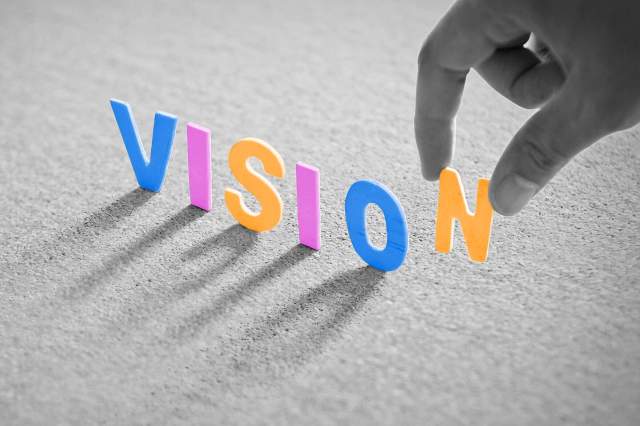
Eyes Actually Perceive Things Upside Down
Much of the work of perceiving the world around us actually takes place in the brain. In a way, our eyes act as a camera, and our brains as a kind of “darkroom” that develops that information into what we call our vision. One of the most perplexing aspects of this dual relationship is that the images projected onto our retina are actually upside-down. Because the cornea — the transparent part of the eye covering the iris and pupil — is a convex lens, when light enters the cornea, it’s flipped upside down. It’s the brain’s job to translate this inverted information, as well as two 2D images, one from each eye, into one cohesive 3D image.

Human Vision Has a Major Blind Spot
When glancing around the world, human vision appears nearly flawless. Although our field of vision, at 180 degrees, is relatively narrow when compared to that of animals such as chameleons (who can see at nearly 360 degrees), the image appears complete, and even delivers fidelity equivalent to 576 megapixels. Despite these strengths, every human eyeball has a pretty sizable blindspot, an area in our vision that would appear invisible if not for some clever tricks developed by our brain. This blind spot occurs where the optic nerve, which carries messages from the retina to the brain, meets the retina. Because there are no photoreceptor cells in this part of the human eye, this small space disappears in human vision. Thankfully, humans are born with two eyes, and our brain fills in the gap with information derived from the opposing eye, so you never actually see this blind spot.

Optical Illusions Are Important for Understanding the Human Brain
The human brain is notoriously tricky to study due to its immense complexity, but optical illusions play a vital role in helping scientists discover how our brains create our reality. One aspect of this complexity is that an estimated 30 areas of the human brain are involved in human vision. Studies have shown that different illusions impact different areas of the brain differently — sometimes, some parts of the visual system correctly identify visual information, while other parts are tricked (for instance, the visual cortex at the back of the brain might not be fooled by an illusion, while the frontal lobe is). Figuring out how this happens can be valuable for scientists.
Some illusions also take advantage of the fact that humans don’t perceive reality instantaneously, but rather in a 100-millisecond lag — or the time it takes for light to transform into electrical impulses to be interpreted by our brain. To make sure we’re not a complete, uncoordinated mess, the visual system in our brain predicts where an object is headed, but sometimes errors in this prediction can cause an optical illusion. This is only one kind of cause (among many) for optical illusions; the way optical illusions happen is nearly as complex as the human brain itself.
More Interesting Reads

Blinking Provides a “Neurological Reset” for Our Brain
Blinking performs a vital role in the human visual system by cleaning the eye’s surface and lubricating it with tears, but there’s a catch — humans blink way more than simple lubrication requires. In fact, humans blink so much that it’s estimated that we spend 10% of our waking hours with our eyes closed. So why do humans tend to blink approximately 12 times a minute? Around 2010, scientists from the University of Osaka observed study participants as they watched snippets of the comedy series Mr. Bean. The subjects tended to blink during scene changes, or when the main actor left a scene. This blinking activated what the scientists call the brain’s “default mode network,” which resulted in a very brief stand-down of other areas of the brain related to attention. The theory is that these very brief pauses in brain function allow humans to refocus attention on something else.

Humans Perceive the Color Red First
After birth, a baby mostly sees in black and white — and that’s only the beginning of its problems. A newborn’s vision is also incredibly fuzzy, and limited to around 8 to 12 inches from its face during the first few weeks of life. Whereas average human sight is considered 20/20, it’s estimated that a newborn’s vision lies somewhere between 20/200 and 20/400. Because red has the longest wavelength (at 700 nanometers), the color doesn’t scatter easily, and it’s the first hue capable of being detected by a baby’s reduced visual range. Within a year, most babies have attained most of the normal human visual faculties, although the ability to accurately judge distances is one of the last skills to be acquired.

Some People, Known as “Tetrachromats,” Can See 100 Million Different Colors
The human eye is a trichromatic system, meaning that three different types of cones are sensitive to three specific colors: red, blue, or green. However, some people have an abnormal gene that creates a fourth cone that’s particularly sensitive to the yellow-green part of the visual spectrum. As a result, instead of the million colors a human can normally see, people with the condition, known as “tetrachromacy” (tetra is a Greek prefix meaning four), can see 100 times that amount. Strangely, scientists believe that only women can inherit this superhuman vision, because of their two X chromosomes. Because the gene that regulates red and green cones is located in the X chromosome, it’s possible that a woman could encode that gene in each X chromosome differently, thus resulting in four types of cones.











